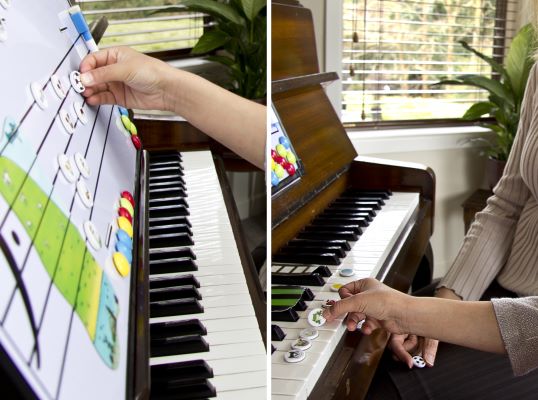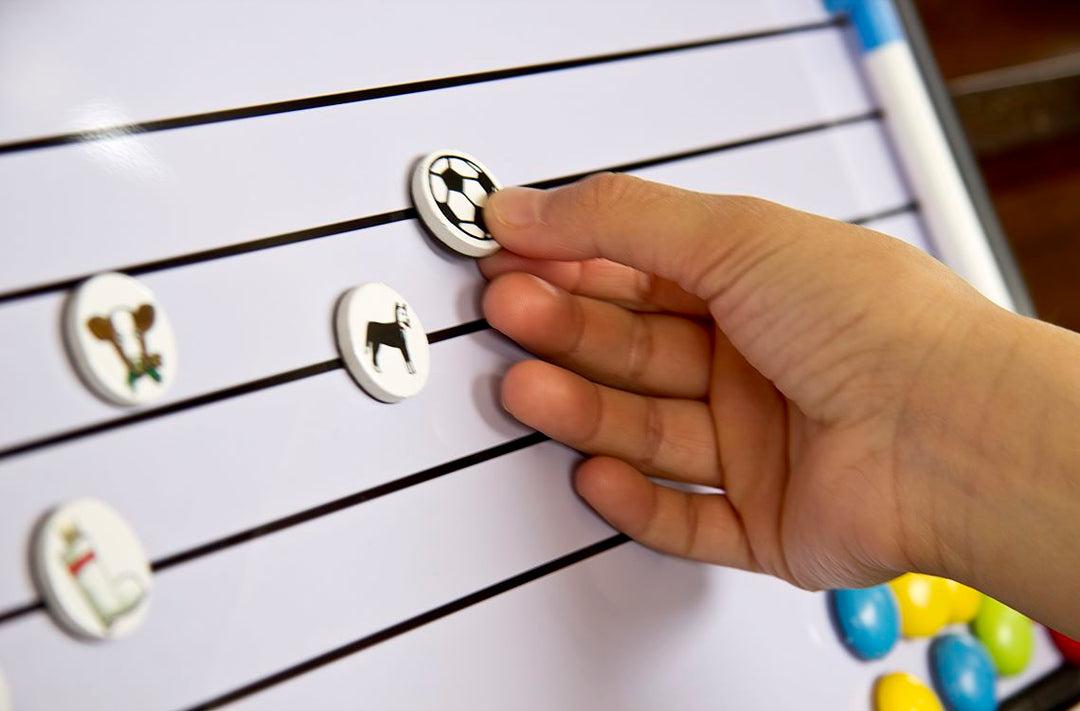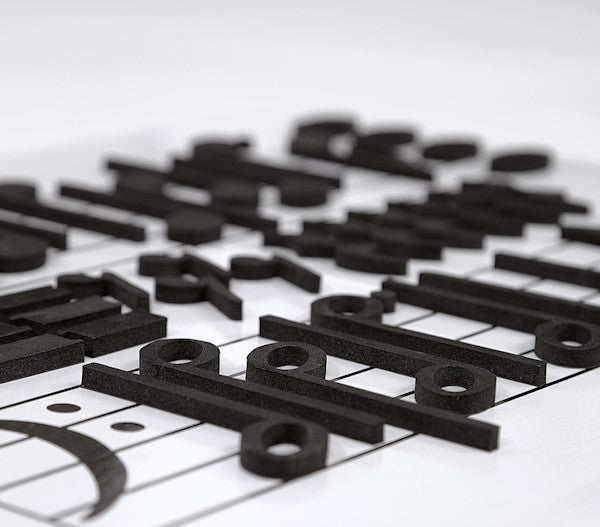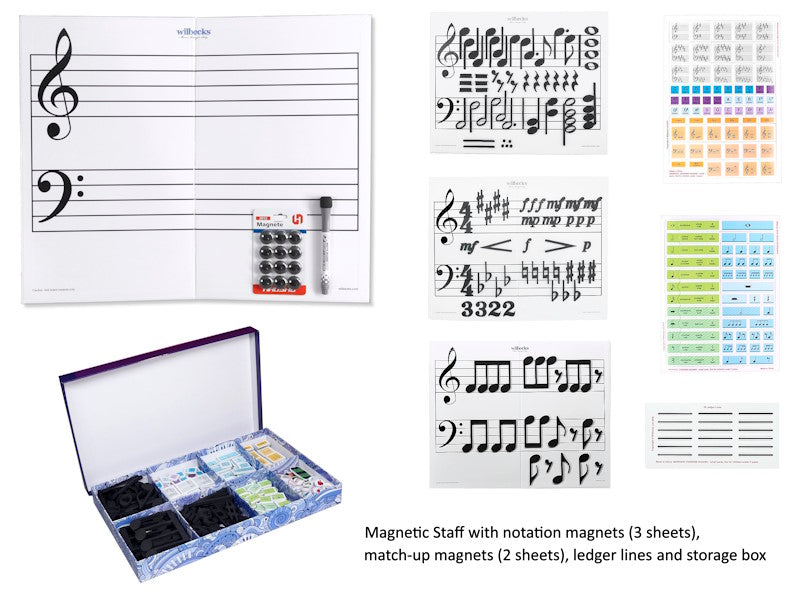How Easy Notes Works - an explanation for music teachers
Learning to read the notes can be so difficult for beginners!
One of the hardest things for a beginner is to learn is to read the notes, and yet being a good note reader is crucial to good musical progress. Knowing what the notes are on the music stave and how they relate to the keys on the piano is the ABC of music reading. It’s essential!But learning the notes can be so easy and fun!
By taking just a few minutes each lesson, you can turn one of the hardest things to learn into the most fun and easy thing to learn!When learning is fun, learning is easy
Everyone loves stories, pictures and playing games. When you teach in this way, learning is easy. With the Easy Notes theory books you can use short stories to teach what the notes are, on the stave and on the piano keyboard. For example:|
On a cold day in Treble Stave Street, the warmest, coziest place for a note to be is right in the middle of the stave, on the middle line. If you were here, you would be as ‘snug as a bug in a rug’.

|
Here a link is made between the note on the middle line of the stave (B) and a bug. The story and the picture of the bug on the middle-line imprints the taught information into the mind and helps the learner to recall it.
With Easy Notes you can also use stories to teach what the notes are on the piano, using the same characters. For example:
|
If the day warms up, Bug B flies down to the piano and sits on this lily pad with three black stripes to enjoy the sunshine. Frog F hides under the lily pad, hoping to catch a tasty treat. Watch out, Bug B!

|
Here another story and picture teach what the notes are on each side of the three black keys. Immediately the student can recall where the F and B notes are found on the piano — each side of the 3 black keys! And as well as that, the story has connected the B note on the stave to the B note on the piano, with Bug B flying down from the middle line of the stave to sit on the note above the lily pad.
Instant recognition of the notes
Learning using stories enables the student to instantly recognize the notes on the stave and connect them to the piano. This is because the stories link to each note’s position on the stave and on the piano. This simple approach saves the student from having to use cumbersome strategies, such as counting up lines and spaces with mnemonics like "Every Good Boy Does Fine". And, in connecting the notes on the stave to the notes on the piano, the stories go further than mnemonics, making them a much more powerful learning tool— see The trouble with mnemonics.Four octaves of notes

The Easy Notes Level 1 and Level 2 theory books teach four octaves of notes using characters and stories.
- Level 1 teaches the C-position and G-position notes on the stave and on the piano.
- Level 2 teaches middle C-position, high G-position and the outer ledger line notes on the stave and on the piano.
Exercises to practice the notes
Once a note is introduced in the Easy Notes theory books, it is continually repeated and confirmed through stories, pictures, and exercises.

Flashcards for further note practice
The theory books also come with a full set of note flashcards for further note practice. The flashcards have clues and pictures on the back related to the stories. If the student can't recall the note then the clue can be read out to jog their memory. This enables parents to help the student revise the notes at home, and confirms what you have taught them in the lesson.Hands-on activity to boost the learning process
 It’s not always easy to provide hands-on activity in our teaching, and yet it greatly enhances the learning process for the student. The Easy Notes Kit enables hands-on activity in the lesson and at home.
It’s not always easy to provide hands-on activity in our teaching, and yet it greatly enhances the learning process for the student. The Easy Notes Kit enables hands-on activity in the lesson and at home. The Kit includes Character Magnets, which relate to the stories in the theory books, and plain black "button" magnets. They can be placed on the Magnetic Stave and also on the keys of the piano in order to practice the notes that have been learned. Teachers report that their students love handling the magnets — to them it’s like a game, and it engages their imagination. It gets them moving and engaging with content, which helps to stimulate the brain to absorb more.
Plenty of repetition leading to assimilation
Therefore, when working through the Easy Notes theory books in the first year of tuition, the student is exposed to continual repetition and practice of the notes they are learning. After enough repetition they don´t need the characters or stories anymore because in their minds the notes on the stave, the notes on the piano and the note names are firmly linked. The characters and stories are simply the vehicle to get them to that knowledge — see Learning music by association
Also teaches rhythm and dynamics
As well as teaching four octaves of notes, Easy Notes also teaches rhythm and dynamics through stories. For example:
The next next time you teach these dynamics to a student, try teaching them this way. You’ll be amazed at how effortlessly the student learns and remembers them!
Two pages of Easy Notes per week
The Easy Notes books are designed to be used at a rate of two pages per week, starting from the very first lesson. Doing so supports the progression of learning stages covered by most piano lesson books in the first year. However, with very young students, you may find that one page per week is adequate to match their rate of progression.Highly effective
Easy Notes teaches in harmony with the way children think and learn, and caters to the various learning styles (visual, auditory, kinaesthetic, read/write) — see Why is Easy Notes so effective.The rich visual component of the books and the hands-on nature of the Magnetic Stave and Characters mean that children can begin learning at a younger age, and yet older children and teenagers really like it too! We're music teachers ourselves, and often begin children as young as 5 years old in piano lessons. This is possible because Easy Notes teaches them how to read music in a way that they can easily learn. We also use Easy Notes to remediate transfer students who have been taught using other methods yet still struggle to read music.
It doesn't change the way you teach
The Easy Notes theory books can be used in conjunction with any piano lesson books and, just like regular theory, Easy Notes doesn’t change your teaching, but supports it.You don't need to prepare either. Using Easy notes is so easy you can learn it together with your student. The books will guide you in what to do. Just turn to the first story and begin!
|
ALL IT TAKES IS A FEW MINUTES EACH LESSON
 Mark Theory Mark Theory At the beginning of the lesson, set up a simple exercise with the magnets and have the student do it while you mark their theory - it will only take you a minute to mark it. Children enjoy handling the magnets, and it’s a nice way to start the lesson.  Practice note recognition with flashcards or magnets Practice note recognition with flashcards or magnets Then turn your attention to the student and ask them to do one or two more exercises with the magnets. You may want to confirm all the notes covered so far, or a selection of notes, such as the C Position treble notes or all of the G Position notes.  Next pages Next pages Read the stories on the next two pages, confirming any new ideas by placing the relevant magnets on the stave or on the piano, and assign the pages as homework. |
It really works
 You’ll find that these few minutes are an excellent time-investment, which starts paying off immediately, enabling students to read music easily and have fun learning to do it!
You’ll find that these few minutes are an excellent time-investment, which starts paying off immediately, enabling students to read music easily and have fun learning to do it!We have received so much feedback over the years attesting to the success of Easy Notes with children as young as four years old, through to teenagers and adults — read some of it here.
Find out more
How Easy Notes Works - an explanation for the self-learnerThe trouble with mnemonics!
Why is Easy Notes so effective?
Learning music by association
A better way to learn music - tell me a story
Piano lesson books Easy Notes works with
Your feedback and successes using Easy Notes
SHOP






